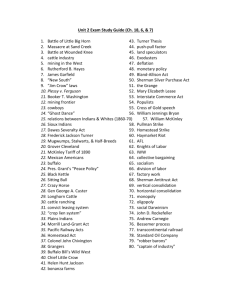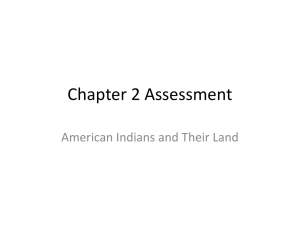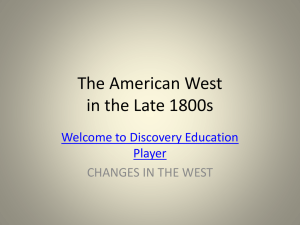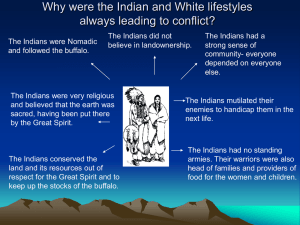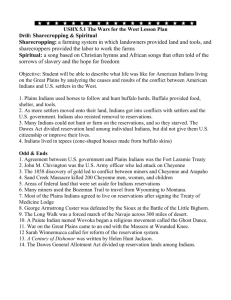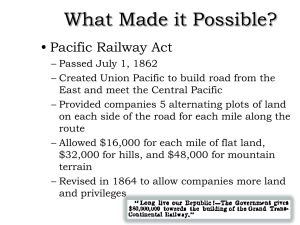ch.18-USII-pp - mrsblackmonhistory
advertisement
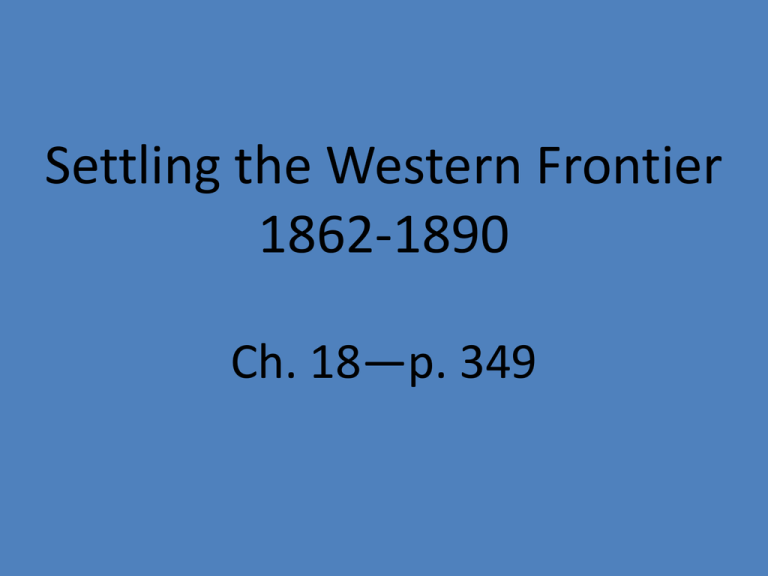
Settling the Western Frontier 1862-1890 Ch. 18—p. 349 Sect 1: The Great Plains • A vast stretch between the Missouri River and the Rocky Mountains • Americans traveled west by stagecoach • St. Louis, MO was the western end of the railroad at this time • Americans were afraid of American Indians • Wagon Trains-brought shipments of supplies (large number of wagons traveling together) • Telegraph- improved communication • Transcontinental Railroad- extended the railroad across the continent • Central Pacific Railroad- Started west (Sacramento CA) and was built east • Union Pacific Railroad-was started in Omaha NE and built west • Chinese immigrants and Irish war veterans were hired to build the railroad • It was dangerous—many killed • Tunnels had to be blasted through mountains • In May of 1869, the two railroads met at Promontory Point, Utah • Central Pacific- more than 700 miles of track • Union Pacific- more than 1,000 miles of track • The Great Plains could be settled easier with the use of the railroad Ch.18-Sect.2- Frontier Life-p.352 • Miners, farmers, and cowhands settled the west Cowhand- people who tended to cattle They searched for gold, built cattle ranches, and claimed land for family farms • Gold was discovered near Pikes Peak, Colorado just before the Civil War • Prospector-a person who searches for gold, silver, and other minerals • Prospectors traveled many miles to the west to find gold • During the 1860s gold was discovered in Montana, Idaho, and Wyoming • Most miners never became rich • Many who traveled west in search for gold settled down and became farmers, ranchers, or loggers • There was a lack of law and order in the west • Many formed city governments • They elected sheriffs Cattle Country • Longhorn cattle were running wild in Texas • Texans rounded up the cattle and raised it for beef, hides, and other goods • Cattle was easy to raise in the Great Plains • Ranchers wanted to bring their cattle to Chicago • They lacked transportation until the railroad was built • Cowhands guided cattle and branded them with the mark of their owner • The Chisholm Trail was a widely used cattle trail • A cattle drive took more than two months • Cowhands spent about 18 hrs. a day in the saddle • Cowtowns were where cowhands stopped to rest • They had many saloons and gambling houses • United States Marshalls provided law in cowtowns • Marshalls like Wild Bill Hickok • The Homestead Act- 1862-made it easy for pioneers to own land • Settlers were given 160 acres if they agreed to live on it for 5 years • Homesteader- a pioneer who owned land under the Homestead Act • Theses farmers found the ground hard to plow and there was little rain • Trees for building and fuel were only found on riverbanks • Farmers began to make houses out of sod • Sod- grass and roots that is thickly matted Sod House Joseph Glidden-Barbed Wire • Barbed wire kept cattle from roaming or wandering off Windmill-powered by the wind to pump water from a well The Plains Indians – Sect 3-p. 356 • Cheyenne, Comanche, Blackfeet and 7 tribes of the Sioux lived on the Plains • They were hunters and nomads • Nomad- walks from place to place in search of food; following buffalo herds Buffalo • Indians ate the meat, used the hides for clothing, shelter and used the bones to make tools Buffalo hide Buffalo hide for Shelter Buffalo bones for tools Killing of the Buffalo • The Army thought if they killed the buffalo they would force the Indians to settle in one place • Farmers and ranchers wanted the buffalo out of their way • Others killed buffalo to sell their hides Wild Bill Cody • Killed more than 4,000 buffalo in 18 months • Got the name “Buffalo” Bill • By 1889, only 541 buffalo survived in the US • Indians were moved to reservations • Reservation-land set aside by the government for the American Indians • Some Indians chose to fight • Reservations were in New Mexico, Arizona, Dakotas and Wyoming Gold Discovered in South Dakota • This land was holy to the Sioux Indians • They believed the “Great Spirit” lived in its hills • The US government promised the Black Hills would belong to the Sioux forever • Prospectors invaded the Black Hills for gold • Chiefs Sitting Bull and Crazy Horse gathered more than 2,000 Sioux and Cheyenne warriors to defend their lands Chiefs Sitting Bull and Crazy Horse gathered more than 2,000 Sioux and Cheyenne warriors to defend their lands • General George Armstrong Custer and the Seventh Cavalry met the Indians at Little Big Horn • Custer and 210 members of his troops were killed Indians are Starving after Victory • Chief Joseph led the Nez Perce as they fled and traveled 1,500 miles in 75 days • Many Indians starved or froze to death • Chief Joseph urged his people to surrender -------“I will fight no more forever” Chief Joseph American Indian Reservations-1890 Chief Red Cloud • Went to Washington D.C. to inform the government of the Sioux’s problems • He said they were dishonest, broke treaties, and instilled fear • Called the President, “Great White Father” to bring peace Congress Aids American Indians-Sect. 4p.360 • A book about how the Indians were mistreated was written by Helen Hunt Jackson—A Century of Dishonor • The Dawes Act-1887- A law that would turn American Indians into independent farmers • Attempted to protect the Indians from being cheated The Battle of Wounded Knee • Indians believed in performing a Ghost Dance • This dance would protect them from bullets, remove white settlers, and bring back the buffalo • The Ghost Dance frightened settlers • An army was sent to prevent violence Wounded Knee Massacre • 290 Indian men, women and children were killed • 25 soldiers were killed Western States Admitted to the Union 1864-1912 1864 – Nevada 1867- Nebraska 1876- Colorado 1889- North Dakota 1889- South Dakota 1889- Montana 1889-Washington 1890- Idaho 1890- Wyoming 1896- Utah 1907- Oklahoma 1912- New Mexico 1912- Arizona
